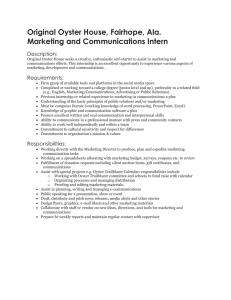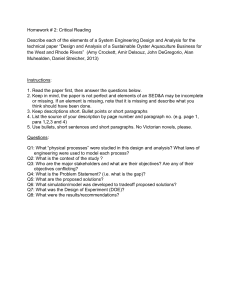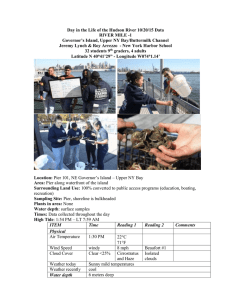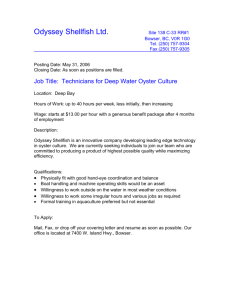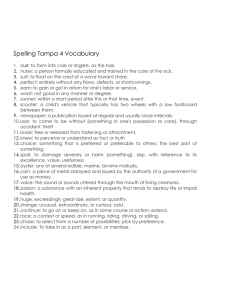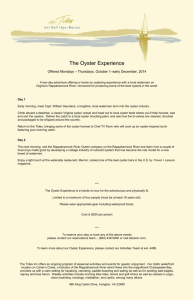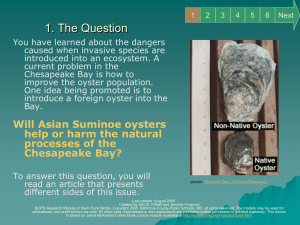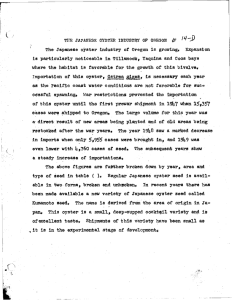charge - Oyster Recovery Partnership
advertisement
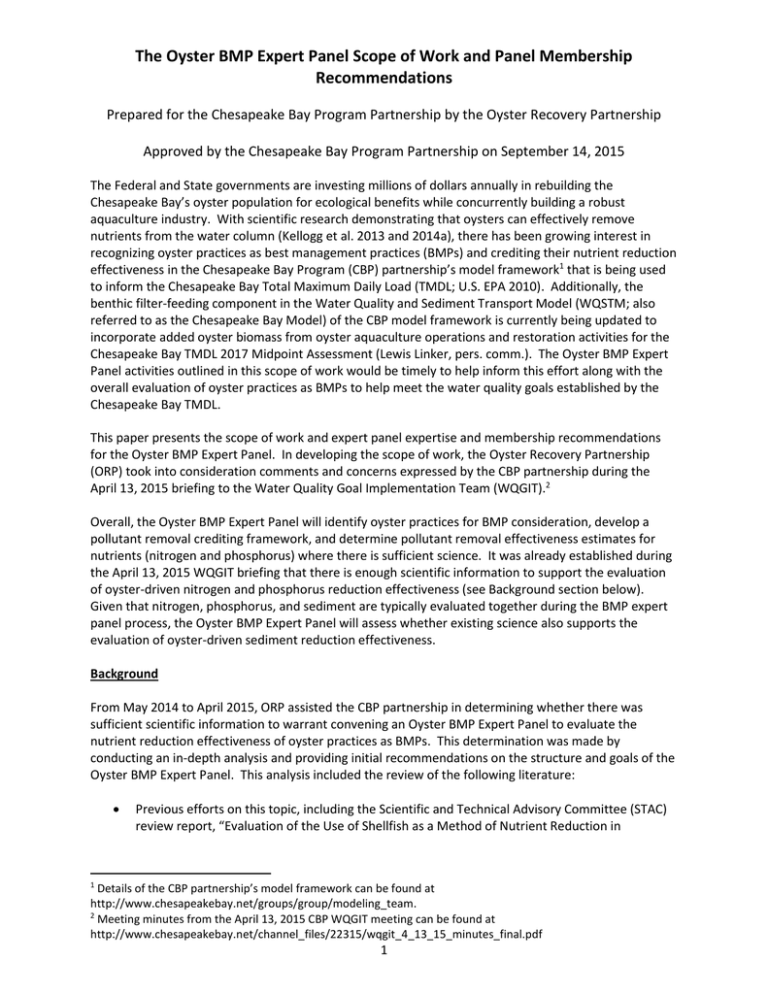
The Oyster BMP Expert Panel Scope of Work and Panel Membership Recommendations Prepared for the Chesapeake Bay Program Partnership by the Oyster Recovery Partnership Approved by the Chesapeake Bay Program Partnership on September 14, 2015 The Federal and State governments are investing millions of dollars annually in rebuilding the Chesapeake Bay’s oyster population for ecological benefits while concurrently building a robust aquaculture industry. With scientific research demonstrating that oysters can effectively remove nutrients from the water column (Kellogg et al. 2013 and 2014a), there has been growing interest in recognizing oyster practices as best management practices (BMPs) and crediting their nutrient reduction effectiveness in the Chesapeake Bay Program (CBP) partnership’s model framework1 that is being used to inform the Chesapeake Bay Total Maximum Daily Load (TMDL; U.S. EPA 2010). Additionally, the benthic filter-feeding component in the Water Quality and Sediment Transport Model (WQSTM; also referred to as the Chesapeake Bay Model) of the CBP model framework is currently being updated to incorporate added oyster biomass from oyster aquaculture operations and restoration activities for the Chesapeake Bay TMDL 2017 Midpoint Assessment (Lewis Linker, pers. comm.). The Oyster BMP Expert Panel activities outlined in this scope of work would be timely to help inform this effort along with the overall evaluation of oyster practices as BMPs to help meet the water quality goals established by the Chesapeake Bay TMDL. This paper presents the scope of work and expert panel expertise and membership recommendations for the Oyster BMP Expert Panel. In developing the scope of work, the Oyster Recovery Partnership (ORP) took into consideration comments and concerns expressed by the CBP partnership during the April 13, 2015 briefing to the Water Quality Goal Implementation Team (WQGIT).2 Overall, the Oyster BMP Expert Panel will identify oyster practices for BMP consideration, develop a pollutant removal crediting framework, and determine pollutant removal effectiveness estimates for nutrients (nitrogen and phosphorus) where there is sufficient science. It was already established during the April 13, 2015 WQGIT briefing that there is enough scientific information to support the evaluation of oyster-driven nitrogen and phosphorus reduction effectiveness (see Background section below). Given that nitrogen, phosphorus, and sediment are typically evaluated together during the BMP expert panel process, the Oyster BMP Expert Panel will assess whether existing science also supports the evaluation of oyster-driven sediment reduction effectiveness. Background From May 2014 to April 2015, ORP assisted the CBP partnership in determining whether there was sufficient scientific information to warrant convening an Oyster BMP Expert Panel to evaluate the nutrient reduction effectiveness of oyster practices as BMPs. This determination was made by conducting an in-depth analysis and providing initial recommendations on the structure and goals of the Oyster BMP Expert Panel. This analysis included the review of the following literature: Previous efforts on this topic, including the Scientific and Technical Advisory Committee (STAC) review report, “Evaluation of the Use of Shellfish as a Method of Nutrient Reduction in 1 Details of the CBP partnership’s model framework can be found at http://www.chesapeakebay.net/groups/group/modeling_team. 2 Meeting minutes from the April 13, 2015 CBP WQGIT meeting can be found at http://www.chesapeakebay.net/channel_files/22315/wqgit_4_13_15_minutes_final.pdf 1 Chesapeake Bay (STAC 2013) and the workshop report, “Quantifying Nitrogen Removal by Oysters” (Kellogg et al. 2013). The oyster BMP request from Steve McLaughlin from the City of Virginia Beach (McLaughlin 2013). Other related BMP efforts, including the Long Island Sound Study workshop report, “International Workshop on Bioextractive Technologies for Nutrient Remediation Summary Report” (Rose et al. 2010) and the Urban Stream Restoration BMP Expert Panel’s report, “Recommendation of the Expert Panel to Define Removal Rates for Individual Stream Restoration Projects (Schueler and Stack 2014). Oyster literature not previously considered in the STAC review (Appendix A).3 The Oyster Recovery Partnership also reached out to several policy and oyster research experts (Table 1) and used the information obtained during these discussions, along with the knowledge obtained from the review above, to develop initial panel recommendations. ORP’s literature review and initial panel recommendations were presented to the WQGIT on April 13, 2015 resulting in the approval by the WQGIT for ORP to convene an Oyster BMP Expert Panel.4 Table 1. Experts consulted by ORP to aid in developing the initial Oyster BMP Expert Panel recommendations presented during the April 13, 2015 WQGIT meeting. Expert Suzanne Ayvazian Carl Cerco Robinson Fulweiler Michael Haire Cecilia Lane Lewis Linker Lucinda Power Tom Schueler Affiliation Research Ecologist, U.S. EPA, Atlantic Ecology Division, Narragansett, RI U.S. Army Engineer Research and Development Center, Vicksburg, MS Associate Director/Professor, Boston University Marine Program, Boston, MA Adjunct Professor, Towson University, formerly with U.S. EPA, Office of Water, TMDL program, Washington D.C. Chesapeake Stormwater Network, Ellicott City, MD Modeling Coordinator, Chesapeake Bay Program Office, U.S. EPA, Annapolis, MD Watershed Implementation Plan Specialist, Chesapeake Bay Program Office, U.S. EPA, Annapolis, MD Chesapeake Stormwater Network, Ellicott City, MD Recommendations for Expert Panel Membership and Expertise The CBP partnership’s BMP Expert Panel Review Protocol5 directs that each expert panel includes the following four representatives: One representative from the Watershed Technical Workgroup (WTWG). One representative from the CBP modeling team. 3 Summaries/references of studies not previously considered during the STAC review were initially presented in the April 13, 2015 briefing materials to the WQGIT and can be found at http://www.chesapeakebay.net/channel_files/22315/appendix_e_literature_review_summaries_by_orp.pdf. 4 The Oyster Recovery Partnership’s Oyster BMP Expert Panel briefing materials and presentation can be found at http://www.chesapeakebay.net/calendar/event/22315/. 5 The CBP partnership’s BMP Expert Panel Review Protocol can be found at http://www.chesapeakebay.net/publications/title/bmp_review_protocol. 2 One representative from EPA Region III. One representative from the requesting source sector Workgroup. Jeff Sweeney, Lewis Linker, and Ed Ambrogio have volunteered to be the WTWG, Chesapeake Bay Program modeling team, and EPA Region III representatives, respectively. Since the Oyster BMP Expert Panel topic does not fall into a specific source sector Workgroup, Lucinda Power from the WQGIT has volunteered to fill this role. Rich Batiuk, from the BMP Verification Workgroup, has also offered to assist the panel in an advisory capacity. Dr. Jeff Cornwell, a research professor at the University of Maryland’s Center for Environmental Science, will be the panel chair, pending WQGIT approval. Dr. Cornwell has extensive oyster, sediment, and nutrient cycling expertise6 and has been actively involved in developing the charge below and providing the panel membership recommendations found in Table 2. Table 2 provides ORP’s list of recommended panel expertise and experts. All recommended experts have been contacted by ORP and have expressed interest in either being a panel member or serving as a representative or advisor. These recommendations would allow the needed perspectives and expertise to determine the use of oyster practices as BMPs and the timely completion of the panel goals and charge items described in the panel scope of work below. Resumes/CVs and Conflict of Interest Disclosure Forms of recommended panel members and panel chair will be sent as separate files to the WQGIT to distribute to the CBP partnership for review. Staff from ORP will coordinate and provide technical support for the panel. ORP coordination activities will include supporting the chair in organizing and facilitating panel meetings and documenting and drafting panel findings in the final report. ORP technical support will include conducting and compiling a comprehensive literature review and data source summary to support the panel review and evaluation of oyster practices. ORP will also compile and summarize relevant information to characterize the current spatial extent and biomass of natural oyster populations, populations associated with oyster restoration, and the amount of oyster’s associated with the Chesapeake Bay’s aquaculture industry. To the extent practicable, the on-bottom and off-bottom aquaculture types will be differentiated. This will inform the expert panel of the current status of oyster densities throughout Chesapeake Bay and the potential magnitude of pollutant removal by oysters. As a secondary objective, this information will also be provided to the CBP modeling team, to update the oyster component of the benthic filter-feeding model in the WQSTM (Lewis Linker, pers. comm.). To facilitate the process of producing a recommendation report in time to inform the Chesapeake Bay TMDL 2017 Midpoint Assessment, ORP recommends that the Oyster BMP Expert Panel includes no more than 13 panelists, excluding the two coordinators from ORP and representatives/advisors from CBP. In accordance with the CBP partnership’s BMP Expert Panel Review Protocol, the Oyster BMP Expert Panel members should not represent entities with potential conflict of interest (e.g., receive financial benefits from panel recommendations). Panelists will be required to identify any potential financial or other conflicts of interest prior to serving on the expert panel through the Conflict of Interest Disclosure Forms. 6 Dr. Cornwell’s CV will be provided to the CBP as part of the panel charge and panel membership approval package. 3 Table 2. List of recommended expertise and experts (panel role in parentheses) for the Oyster BMP Expert Panel. 4 Oyster BMP Expert Panel Scope of Work The Oyster BMP Expert Panel will be charged to focus on the following overall goals in relation to the CBP partnership’s Expert BMP Panel Review Protocol for nutrient and sediment controls: 1. Reach a consensus on acceptable pollutant reduction effectiveness estimates for oyster practices in Chesapeake Bay based on existing science. 2. Determine a methodology to update these estimates when new science becomes available. 3. Establish pollutant removal crediting and verification guidelines as it relates to their application in the CBP partnership’s model framework used to inform the Chesapeake Bay TMDL. To support the achievement of the above goals, ORP and the proposed panel chair recommend that the Oyster BMP Expert Panel complete the following three charge items: 1. Identify and define oyster practices, including aquaculture operations and restoration activities for nutrient removal BMP consideration. Evaluate whether existing science supports the evaluation of sediment reduction effectiveness. 2. Develop a pollutant removal crediting decision framework that will allow the incremental approval of pollutant reduction effectiveness estimates for individual oyster practices and associated pollutant removal/nutrient cycling processes (e.g., nitrogen and phosphorus bioassimilation in tissue, nitrogen and phosphorus bioassimilation in shell, nitrogen removal via denitrification). 3. Using the established framework from charge item 2, propose pollutant removal effectiveness estimates that are determined to have sufficient science for one or more applicable pollutant removal/nutrient cycling processes to help inform the Chesapeake Bay TMDL 2017 Midpoint Assessment. The rationale and associated panel tasks for each charge item is further described below. Charge Item 1 The first charge item is needed because oyster practices have not been formerly evaluated for their use as BMPs to meet water quality goals established by the Chesapeake Bay TMDL. Therefore, the Oyster BMP Expert Panel members will provide recommendations on which oyster practices (i.e., aquaculture operations, restoration activities) will receive nutrient removal BMP consideration. Specifically, the panel will determine whether oyster practices should be given their own BMP classification (e.g., bioextraction BMP, in situ BMP) or if they fit in an existing BMP classification. The panel will also define how these oyster practices could be used in the CBP model framework given that oysters would in effect be removing nutrients after they have entered the water and would likely differ in the amount of permanent nutrient removal. Oyster practices for potential BMP consideration are listed in Table 3. The panel may add or omit practices based on discussion outcomes. The panel will also determine whether existing science supports the evaluation of oyster-driven sediment removal effectiveness estimates. The Long Island Sound Study’s workshop report, “International Workshop on Bioextractive Technologies for Nutrient Remediation Summary Report” (Rose et al. 2010) could be used as a resource to help structure this conversation. This workshop included policy, industry, and science experts and was structured with goals 5 designed to explore the feasibility of using bioextractive aquaculture,7 including oyster practices, for nutrient management purposes and applying these technologies within the state and federal regulatory framework (i.e., incorporation into the Long Island Sound TMDL). Table 3. List of oyster practices for potential BMP consideration. Oyster practices in Chesapeake Bay include intensive or extensive off bottom, near bottom, and on bottom aquaculture and oyster reef recovery activities in areas where harvesting is and is not permitted. Extensive practices are those activities that cultivate natural wild stocks and intensive practices are those that cultivate hatchery-produced oysters. Spat-on-shell refers to oyster larvae that have settled onto shell and then planted. Category Oyster Practice Description 1 Intensive Off Bottom Suspended Aquaculture Hatchery-produced, cultchless oysters reared in floating cages near the surface for harvesting purposes. 2 Intensive Near Bottom Cage or Rack-and-Bag Aquaculture Hatchery-produced, cultchless oysters reared in cages or bags near the bottom for harvesting purposes. 3 Intensive Spat-on-Shell Bottom Aquaculture Hatchery-produced spat-on-shell planted on bottom leases for harvesting purposes. Intensive Spat-on-Shell Bottom Public Fishery Intensive/Extensive Spat-onShell Bottom Restoration Hatchery-produced, spat-on-shell planted on public shellfish fishing areas (PFSAs) for eventual harvest. Hatchery-produced, spat-on-shell planted to promote natural reproduction in areas where harvesting is not permitted (e.g., sanctuaries). Planting oyster shells on the lease bottom to attract recruitment of natural (wild) oysters for harvesting purposes. Planting oyster shells on public shellfish fishing areas to attract recruitment of natural (wild) oysters for harvesting purposes. 4 5 6 Extensive Shell Planting Aquaculture 7 Extensive Shell Planting Public Fishery Charge Item 2 Due to the differences between oyster practices and their intended outcomes (harvest allowed versus harvest not allowed) and the current state of knowledge of associated pollutant removal/nutrient cycling processes, there is a need for a pollutant removal crediting decision framework that would allow incremental approval of oyster practices and associated pollutant removal/nutrient cycling processes on an individual basis. Therefore, the Oyster BMP Expert Panel will be tasked with developing such a framework. This framework should include the following: Pollutant removal crediting and verification guidelines. Method for updating estimates when new science becomes available. Guidelines for addressing uncertainty and variability in pollutant removal effectiveness. 7 Defined as the practice of farming and harvesting shellfish and seaweed for the purpose of removing nitrogen and other nutrients from the natural water bodies (http://longislandsoundstudy.net/issues-actions/water-quality/nutrientbioextraction-overview/) 6 The framework concept established by the Urban Stream Restoration BMP expert panel and approved by the WTWG and WQGIT in 2013 (Schueler and Stack 2014) could be used as a starting point to begin developing a pollutant removal crediting framework for oyster practices for individual pollutant removal processes (see Figure 1 for a hypothetical example). Figure 1. A hypothetical example of a pollutant removal crediting framework that considers oyster practices and pollutant removal processes on an individual basis. The individual crediting protocols would be applied to determine the pollutant removal effectiveness of an individual oyster practice if they are applicable to that oyster practice based on the approved pollutant removal crediting guidelines and have sufficient science to establish a pollutant removal effectiveness estimate. It will be important for the panel to establish how the crediting and verification of individual oyster practices and associated pollutant removal processes (e.g., nutrient cycling) should occur, given that these practices would differ in the potential amount of permanent pollutant removal (e.g., practices where harvest is allowed, such as in oyster aquaculture, versus practices where harvest doesn’t occur, such as oyster restoration in sanctuaries) and are influenced by varying environmental conditions (e.g., location-driven variability in denitrification rates; Kellogg et al. 2013 and 2014a, STAC 2013). Additionally, the panel should also provide recommendations on whether pilot studies are needed to test any of the crediting/verification guidelines. Panel members will only establish crediting and verification guidelines for practices and pollutant removal processes where there is sufficient science to do so. The final recommendation report should include panel conclusions for why any practices, pollutants, and/or pollutant removal processes were not evaluated. Charge Item 3 The 2013 oyster workshop (Kellogg et al. 2013) and the STAC review (STAC 2013) laid the necessary groundwork for an oyster BMP by having 30 experts do a comprehensive literature review and additional experts from STAC providing recommendations on how the reviewed data could be applied in the CBP partnership’s modeling tools. Using the established pollutant removal crediting decision framework from charge item 2, the panel will apply the results from these past efforts and evaluate any new research from studies that weren’t previously considered (Appendix A and any additional studies identified by the panel) to propose pollutant removal effectiveness estimates for oyster practices that are determined to have sufficient science for one or more applicable pollutant removal crediting protocol to help inform the Chesapeake Bay TMDL 2017 Midpoint Assessment. ORP will also provide information on current and potential future (2025) 7 oyster biomass to help with this discussion given that oyster biomass from oyster aquaculture and sanctuaries has been identified as an important element in updating the oyster component of the benthic filter-feeding model in the WQSTM. From ORP’s initial literature search (Appendix A), ORP identified studies that had not been considered and/or completed in time for the 2013 STAC review report that tested modeling methodologies to understand the nutrient removal potential of different oyster practices and in some cases compared them to existing nutrient load reduction/Chesapeake Bay TMDL activities (Kellogg et al. 2014b) or to nutrient-reducing BMPs (waste water treatment technologies [Pollack et al. 2013], stormwater and agricultural BMPs [Rose et al. 2014]). It would be useful for the expert panel to also consider these different modeling approaches and determine if they would be acceptable to fill in any knowledge gaps concerning nutrient removal effectiveness. Timeline and Deliverables The Oyster BMP Expert Panel timeline of deliverables is in line with the Chesapeake Bay TMDL 2017 Midpoint Assessment and recommendations will be developed with the intention to help inform the CBP partnership’s modeling tools/framework, including updates to the oyster component of the benthic filter-feeding model in the WQSTM. The Oyster BMP Expert Panel will work with the CBP partnership to develop a report that includes recommendations for an oyster BMP pollutant removal crediting framework and information as described in the CBP partnership’s BMP Expert Panel Review Protocol (see summary in Appendix B). Final approval of panel recommendations will be from the WQGIT, in coordination with the Habitat and Fisheries GITs. To provide recommendations in time for the Chesapeake Bay TMDL 2017 Midpoint Assessment, the panel will first complete charge items 1 and 2 and provide a paper defining oyster practices for BMP consideration and a pollutant removal crediting decision framework for nitrogen and phosphorus (and possibly sediment, depending on conclusions from charge item 1) to be approved by the WQGIT, in coordination with the Habitat and Fisheries GITs. The panel will then use the approved framework to propose pollutant removal effectiveness estimates of oyster practices that are determined to have sufficient science for one or more applicable nutrient cycling/pollutant removal processes to help inform the Chesapeake Bay TMDL 2017 Midpoint Assessment. September 2015—Convene panel. October 2015—Panel stakeholder meeting. December 2015—Target date for Oyster BMP Pollutant Removal Crediting Decision Framework paper (charge items 1 and 2) for approval by the WQGIT, in coordination with the Habitat and Fisheries GITs. May 2016—Target date for panel to release full nutrient removal effectiveness recommendations (charge item 3) and final report for oyster practices where there is sufficient science for one or more applicable pollutant removal processes for approval by the WQGIT, in coordination with the Habitat and Fisheries GITs. The report will also provide reasons why certain oyster practices, pollutants, and/or pollutant removal processes were not considered, in addition to the information described in the CBP partnership’s BMP Expert Panel Review Protocol. August 2016—If approved, panel recommendations are final and their application will be considered in the CBP modeling tools. 8 References Kellogg, M.L., M.W. Luckenbach, B.L. Brown, R.H. Carmichael, J.C. Cornwell, M.F. Piehler, M. S. Owens, D.J. Dalrymple, C. B. Higgins and A.R. Smyth. 2013. Quantifying nitrogen removal by oysters. Workshop Report. NOAA Chesapeake Bay Program Office, Annapolis, MD. Kellogg, M.L., A.R. Smyth, M.W. Luckenbach, R.H. Carmichael , B.L. Brown, , J.C. Cornwell, M.F. Piehler, M. S. Owens, D.J. Dalrymple, and C. B. Higgins. 2014a. Use of oysters to mitigate eutrophication in coastal waters. Estuarine, Coastal and Shelf Science 151: 156-168, http://dx.doi.org/10.1016/j.ecss.2014.09.025. Kellogg, M.L., M.J. Brush, E.W. North. 2014b. A model for estimating the TMDL-related benefits of oyster reef restoration. A Final Report to the Oyster Recovery Partnership and the National Fish and Wildlife Foundation. McLaughlin, S. 2013. Sanctuary Oyster Reefs as a BMP. Memorandum to James Davis-Martin, Virginia Department of Conservation & Recreation, June 20, 2013. Pollack, J.B., D. Yoskowitz, H.C. Kim, P.A. Montagna. 2013. Role and value of nitrogen regulation provided by oysters (Crassostrea virginica) in the Mission-Aransas estuary, Texas, USA. PLOS One, DOI: 10.1371/journal.pone.0065314. Rose, J.M., M. Tedesco, G.H. Wikfors, C. Yarish. 2010. International workshop on bioextractive technologies for nutrient remediation summary report. US Department of Commerce, Northeast Fisheries Science Center Reference Document 10-19. Rose, J.M., S.B. Bricker, J.G. Ferreira. 2014. Comparative analysis of modeled nitrogen removal by shellfish farms. Marine Pollution Bulletin, http://dx.doi.org/10.1016/j.marpolbul.2014.12.006. Schueler, T. and Stack, B. 2014. Recommendations of the expert panel to define removal rates for individual stream restoration projects. Available at http://www.chesapeakebay.net/documents/Final_CBP_Approved_Stream_Restoration_Panel_report_LONG_ with_appendices_A-G_02062014.pdf STAC (Chesapeake Bay Program Scientific and Technical Advisory Committee). 2013. Evaluation of the Use of Shellfish as a Method of Nutrient Reduction in the Chesapeake Bay. STAC Publ. #13-005, Edgewater, MD. 65 pp. U.S. EPA. 2010. Chesapeake Bay TMDL. Available at http://www.epa.gov/reg3wapd/tmdl/ChesapeakeBay/tmdlexec.html 9 Appendix A: Summaries/references of individual studies not considered during the 2013 STAC review. ID # 1 Lead Author(s) Ayvazian, Suzanne and Fulweiler, Robinson W. Publication Date Ongoing Publication/Project Title N Cycling Processes Across an Oyster Aquaculture Chronosequence Lead Author Organization US EPA, Office of Research and Development, Atlantic Ecology Division and Boston University, Boston, MA Coauthors/ Partners Boze Hancock (The Nature Conservancy/ U. of RI) Steve Brown (The Nature Conservancy, RI Chapter) Scientific Information Type Summary of Project Geographic Location(s) Researched Species Oyster Practice(s) Nitrogen (N) Phosphorus (P) Ongoing study from 2013-present Use of novel in-situ benthic chamber experiments to quantify the influence of oyster aquaculture, oyster reef restoration, and cultch placement on N2 and N2O fluxes across the sedimentwater interface. Shallow (~1m) estuary in southern New England, US Eastern oyster, C. virginica Aquaculture and reef restoration Denitrification - Mid Potomac River mainstem, USA Eastern oyster, C. virginica Extensive on bottom, spat on shell aquaculture Removal of assimilated N (via harvest) - Chesapeake Bay Eastern oyster, C. virginica Oyster Restoration Denitrification - Assimilation and excretion of ingested particulate organic N Assimilation and excretion of ingested particulate organic P (results are not shown, but model can compute this) Robinson W. Fulweiler (Boston University) 2 3 4 Bricker, Suzanne B. Cerco, C.F. Ferreira, J.G. 2014 From Headwaters to Coast: Influence of Human Activities on Water Quality of the Potomac River Estuary National Oceanic and Atmospheric Administration, Silver Spring, MD, USA; email: Suzanne.Bricker@noaa.gov Rice (U. of VA); Bricker (USGS) Peer-reviewed publication in Aquatic Geochemistry, DOI 10.1007/s10498-0149226-y 2007 Can oyster restoration reverse cultural eutrophication in Chesapeake Bay U.S. Army Engineer Research and Development Center, 3909 Halls Ferry Road, Vicksburg, MS Noel, M.R. (U.S. Army Engineer Research and Development Center) Peer-reviewed publication in Estuaries and Coasts, 30(2): 331-343 2007 Management of productivity, environmental effects and profitability of shellfish aquaculture — the Farm Aquaculture Resource Management (FARM) model IMAR — Institute of Marine Research, Centre for Ecological Modelling, IMAR– DCEA, Fac. Ciencias e Tecnologia, Qta Torre, 2829516 Monte de Caparica, Portugal Hawkins (Plymouth Marine Lab); Bricker (NOAA) Peer-reviewed publication in Aquaculture 264: 160-174 10 Model analysis of the nitrogen contribution of headwaters, nontidal, and estuarine portions of Potomac River watershed to total nitrogen loads to Chesapeake Bay. Used eutrophication model to evaluate nitrogen loading changes since 1990s. Used FARM model to determine oyster aquaculture potential to mediate eutrophication impacts. Applied an oyster module to a predictive eutrophication model to investigate the hypothesis that effects of cultural eutrophication can be reversed through natural resource restoration. Describes model for assessment of coastal and offshore shellfish aquaculture at the farmscale and presents results from several case studies. Model allows (i) prospective analyses of culture location and species selection; (ii) ecological and economic N/A (scenariobased) C. gigas On bottom and suspended aquaculture ID # Lead Author(s) Publication Date Publication/Project Title Lead Author Organization Coauthors/ Partners Scientific Information Type Summary of Project Geographic Location(s) Researched Species Oyster Practice(s) Nitrogen (N) Phosphorus (P) Oyster Restoration Did not directly estimate N removal, but instead estimated food web effects of increased oyster biomass resulting from oyster restoration activities (i.e., changes in phytoplankton production from oyster filter-feeding). Did not directly estimate P removal, but instead estimated food web effects of increased oyster biomass resulting from oyster restoration activities (i.e., changes in phytoplankton production from oyster filter-feeding). Reef restoration Filtration rates could inform N removal rates (not evaluated in study) Filtration rates could inform P removal rates (not evaluated in study) optimization of culture practice, such as timing and sizes for seeding and harvesting, densities and spatial distributions (iii) environmental assessment of farm-related eutrophication effects (including mitigation). 5 6 Fulford, R.S. Gedan, Keryn B. 2010 2014 Evaluating ecosystem response to oyster restoration and nutrient load reduction with a multispecies bioenergetics model Department of Coastal Sciences, University of Southern Mississippi, Gulf Coast Research Laboratory, 703 East Beach Drive, Ocean Springs, MS 39564 Accounting for multiple foundation species in oyster reef restoration benefits Department of Biology, University of Maryland, College Park, MD 20742, U.S.A.; Smithsonian Environmental Research Center, Edgewater, MD 20137, U.S.A.; Address correspondence to K. B. Gedan, email kgedan@umd.edu Breitburg, D.L. (Smithsonian Environmental Research Center); Luckenbach, M. (Virginia Institute of Marine Science); Newell (Horn Point Laboratory, University of Maryland Center for Environmental Science) Kellogg (VIMS); Breitburg (Smithsonian Environmental Research Center) Peer-reviewed publication in Ecological Applications, 20(4): 915-934 Developed a network simulation model to examine ecosystem-level responses to management. Applied model to compare nutrient load reduction and restoration of the eastern oyster in Chesapeake Bay. Peer-reviewed publication in Restoration Ecology 22(4): 517-524 Compared temperaturedependent phytoplankton clearance rates and filtration efficiency of Eastern oyster (C. virginica)/reefs with and without hooked mussel (I. recurvum) using lab (with field component) and model results to inform filtration capacity of restored oyster reef at the tributary-scale. 11 Chesapeake Bay tributaries, Patuxent and Choptank Rivers Eastern oyster, C. virginica Rhode River, MD, USA Eastern oyster, C. virginica; hooked mussel, I. recurvum ID # 7 8 9 10 Lead Author(s) Grizzle, R. Kellogg, Lisa M. Kellogg, Lisa M. Pollack, Jennifer B. Publication Date Publication/Project Title Lead Author Organization Coauthors/ Partners 2014 Nitrogen and Carbon Content of Farmed Eastern Oysters (Crassostrea virginica) In the Great Bay Estuary, New Hampshire New Hampshire, School of Marine Science and Ocean Engineering, Jackson Estuarine Laboratory, Durham, NH 03824 Ward, K. and Peter, C. (U. of NH); Cantwell, M., Katz, D., and Sullivan, J. (U.S. EPA) Virginia Institute of Marine Science (VIMS), College of William and Mary, P.O. Box 1346, Gloucester Point, VA 23062, USA Smyth and Luckenbach (VIMS); Carmichael and Dalrymple (U. of S. Alabama); Higgins (Dauphin Island Sea Lab); Brown (Virginia Commonwealth U.); Cornwell and Owens (University of Maryland Center for Environmental Science); Piehler (U. of NC) 2014 A model for estimating the TMDLrelated benefits of oyster reef restoration Virginia Institute of Marine Science (VIMS), College of William and Mary, P.O. Box 1346, Gloucester Point, VA 23062, USA Brush, M.J., (VIMS); North, E.W. (University of Maryland Center for Environmental Science) 2013 Role and value of nitrogen regulation provided by oysters (Crassostrea virginica) in the Mission-Aransas Estuary, Texas, USA Department of Life Sciences, Texas A&M UniversityCorpus Christi, Corpus Christi, Texas, United States of America; jennifer.pollack@tamucc.edu Yoskowitz and Montagna (Texas A&M UniversityCorpus Christi); Kim (I.M. Systems Group) 2014 Use of oysters to mitigate eutrophication in coastal waters Scientific Information Type Summary of Project Geographic Location(s) Researched Species Oyster Practice(s) Nitrogen (N) Phosphorus (P) Final report to NOAA Measured the nitrogen and carbon content in the tissues and shells of oysters of varying age and sizes at six sites over three separate years (2010, 2011, and 2012). Great Bay Estuary, New Hampshire, USA Eastern oyster, C. virginica Intensive Near Bottom Rack-andBag Aquaculture Assimilation - Eastern oyster, C. virginica Intensive aquaculture (near bottom and suspended cages); extensive aquaculture oyster reef; restored and natural oyster reefs Discusses assimilation, denitrification, and long-term N burial from other studies (data previously evaluated during 2013 STAC Review) - Oyster Restoration Assimilation in tissue and shell, denitrification, and burial associated with restored oyster reefs Assimilation in tissue and shell and burial associated with restored oyster reefs Harvested subtidal oyster reefs Removal of assimilated N (via harvest), denitrification, and burial of N as biodeposits in sediment - Peer-reviewed publication in Estuarine, Coastal and Shelf Science 151: 156-168 Final report to the National Fish and Wildlife Foundation and the Oyster Recovery Partnership Peer-reviewed publication in PLoS One 8(6): e65314, doi 10.1371/journal.pone.0065314 12 Presents and discusses the meta-analysis from the 2013 Quantifying Nitrogen Removal by Oysters Workshop Report. Focused on field studies (laboratoryonly studies were excluded). Developed a user-friendly, web-accessible model based on scientificallydefensible data that allows restoration practitioners and resource managers to estimate TMDL-related benefits of oyster reef restoration per unit area. Study considered nitrogen regulation by C. virginica in Texas estuary as a function of denitrification, burial, and physical transportation from the system via harvest and development of a transferrable method to value nitrogen removal by oysters. Field data was collected to establish the baseline for water quality (salinity, temp., dissolved oxygen, pH, chlorophyll-a, Varies, includes Chesapeake Bay (see Table 1 in paper) Chesapeake Bay tributary, Harris Creek MissionAransas estuary, Texas, USA oysters (general) Eastern oyster, C. virginica ID # 11 12 Lead Author(s) Rose, Julie M. Rose, Julie M. Publication Date Publication/Project Title Lead Author Organization Coauthors/ Partners 2014 Comparative analysis of modeled nitrogen removal by shellfish farms NOAA Fisheries, Northeast Fisheries Science Center Milford Laboratory, 212 Rogers Avenue, Milford, CT 06460, USA Bricker (NOAA National Center for Coastal Ocean Science); Ferreira (New University of Lisbon, IMAR) 2014 A Role for Shellfish Aquaculture in Coastal Nitrogen Management NOAA Fisheries, Northeast Fisheries Science Center Milford Laboratory, 212 Rogers Avenue, Milford, CT 06460, USA Bricker and Wikfors (NOAA NCCOS); Tedesco (U.S. EPA) Scientific Information Type Peer-reviewed publication in Marine Pollution Bulletin, http:// dx.doi.org/10.1016/j.marpolbul.2014.12.006 Peer-reviewed publication in Env Sci and Tech, dx.doi.org/10.1021/es4041336 13 Summary of Project total suspended solids) and oyster height and biomass variables. Existing field and lab measurements were used to estimate N removal. Value of nitrogen removal was compared to wastewater treatment plant. FARM model analysis of nitrogen removal at the shellfish farm scale from 14 locations in 9 countries across 4 continents. Model results suggest nitrogen removal from shellfish farms compare to commonly applied agricultural and stormwater runoff BMPs on a per-acre basis. Uses information from other studies to evaluate the potential and challenges in incorporating shellfish aquaculture in nutrient management programs. Geographic Location(s) Researched Species Oyster Practice(s) Nitrogen (N) Phosphorus (P) Potomac River, USA (see Table 1 in paper for other locations) Eastern oyster, C. virginica (see Table 1 in paper for other species) On bottom and suspended aquaculture Removal of assimilated N (via harvest) - Aquaculture (general) Discusses assimilation and denitrification from other studies - Long Island Sound, Chesapeake Bay, Narragansett Bay oysters (general) Appendix B: Outline for Final Expert Panel Reports Summary of information to be included in the panel’s report from the CBP partnership’s BMP Expert Panel Review Protocol. The full protocol can be found at http://www.chesapeakebay.net/publications/title/bmp_review_protocol. The panel report should include the following information: Identity and expertise of Panel members. Land Use or practice name/title. Detailed definition of the practice: o The definition should incorporate descriptive elements that can reasonably be checked by anyone involved in the verification assessment of the practice and result in replicable verification findings. Nitrogen, phosphorus, and sediment loading or effectiveness estimates (practice performance recommendations): o Discussion may include alternative modeling approaches to accommodate a specific land use or practice, if appropriate. o Bioavailability of nutrient load considered, where applicable. o Nutrient content of sediment load considered, where applicable. o Summaries of observed empirical results from studies used as the primary basis for the panel recommendations (including measure of unexplained variation). Justification for the selected effectiveness estimates, including: o List of all data sources considered (peer-reviewed, unpublished, etc.) and a description of how each data source was considered. Panel members can use unpublished data if such data is based on solid documentation as to the origins and the quality of the data. o Identify data sources that were considered, but not used in determining practice effectiveness estimates. o Documentation of uncertainties in the published literature (across and within studies). o Documentation of how the Panel addressed negative results or no pollution reduction in nutrient and sediment loads as a result of implementation of a specific practice. Where studies with negative or no pollution reduction data are found (i.e. the practice acted as a source of pollutants), they should be considered the same as all other data. Explanation of the approach the Expert Panel used to address scientific uncertainties and variation in empirical findings of removal effectiveness (e.g. if "conservative" effectiveness estimates are used to address uncertainty, provide a rationale for the estimate). Description of how best professional judgment was used, if applicable, to determine effectiveness estimates. Land uses to which the BMP is applied. Load sources that the BMP will address and potential interactions with other practices. Description of pre-practice and post-practice circumstances, including the baseline conditions for individual practices. Conditions under which the practice performs as intended/designed: o Include conditions/circumstances where the practice will not perform as intended/designed, or will be less effective. An example: large storm events that could exceed a practice’s design specifications. o Any variations in practice performance due to climate variability, hydrogeomorphic region, geologic material/soil type, or other measureable factors. 14 Temporal performance of the practice including lag times between establishment and full functioning, if applicable. Unit of measure (e.g., feet, acres). Locations within the tidal Chesapeake Bay where this practice is applicable. Useful life; effectiveness of practice over time: o The Panel will work with the WTWG and the CBP modeling team representatives to recommend a “credit duration” for each practice. This determines the time the practice will receive credit in the CBP modeling tools. When the credit duration ends, the practice will need to be verified following the appropriate jurisdictional verification protocols to ensure it is still performing properly in accordance with the practice’s definition, and thereby renewing the credit duration. Cumulative or annual practice. Recommended description of how the practice could be tracked, reported, and verified: o Include a clear indication that this practice will be used and reported by jurisdictions. Guidance on BMP Verification: o Description of the BMP verification guidance must be consistent with the CBP partnership’s Chesapeake Bay basinwide BMP Verification Framework10. Note that verification protocols and the verification of a practice is ultimately the responsibility of a jurisdiction. Panels are expected to provide only their recommendations as to how verification might be considered. Description of how the practice may be used to relocate pollutants to a different location. An example is where a practice eliminates a pollutant from surface transport but moves the pollutant into groundwater. Suggestion for a review timeline; when will additional information be available that may warrant a re-evaluation of the practice effectiveness estimate. Outstanding issues that need to be resolved in the future and a list of ongoing studies, if any. Documentation of any dissenting opinion(s) if consensus cannot be reached. Operation and Maintenance requirements and how neglect alters the practice effectiveness estimates. A brief summary of BMP implementation and maintenance cost estimates, when this data is available through existing literature. In an effort for the Partnership to more efficiently approve the technical requirements for Scenario Builder, National Environmental Information Exchange Network (NEIEN), and the WQSTM that are required by each Panel report, the CBPO Scenario Builder and Modeling Team will work with the Panel members and the WTWG to develop a technical appendix that describes changes that will be made to the modeling and reporting tools to accommodate the BMP(s). Specific text will include the NEIEN-based procedures for flagging and removing practice data that is past its credit duration. The technical appendix should be developed in conjunction with the Panel report to help ensure that recommendations can be fully incorporated into the CBP modeling tools. Once drafted, each technical appendix will move through the comment process in conjunction with its parent report and must be approved by the source sector Workgroup, the WTWG, and the WQGIT. Any future changes to the approved appendix should be brought to the attention of the appropriate source sector Workgroup, WTWG, and WQGIT. Additional Guidelines Identify any significant ancillary benefits or unintended consequences beyond impacts on nitrogen, phosphorus and sediment loads: o Emphasis should be placed on benefits or consequences that have the potential to impact the implementation of the Goals and Outcomes of the 2014 Chesapeake Bay Watershed Agreement. 15
